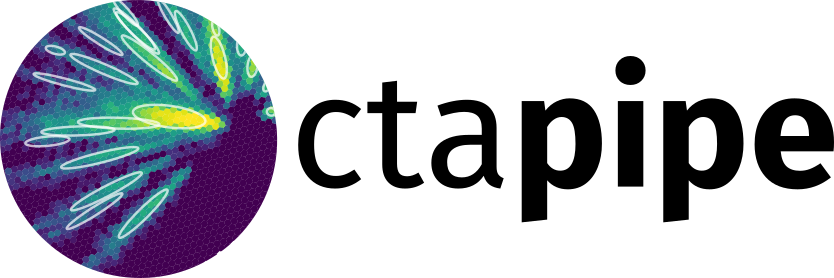# Licensed under a 3-clause BSD style license - see LICENSE.rst
# -*- coding: UTF-8 -*-
"""
Hillas-style moment-based shower image parametrization.
"""
import astropy.units as u
import numpy as np
from astropy.coordinates import Angle
from ..containers import CameraHillasParametersContainer, HillasParametersContainer
HILLAS_ATOL = np.finfo(np.float64).eps
__all__ = ["hillas_parameters", "HillasParameterizationError"]
[docs]
def camera_to_shower_coordinates(x, y, cog_x, cog_y, psi):
"""
Return longitudinal and transverse coordinates for x and y
for a given set of hillas parameters
Parameters
----------
x: u.Quantity[length]
x coordinate in camera coordinates
y: u.Quantity[length]
y coordinate in camera coordinates
cog_x: u.Quantity[length]
x coordinate of center of gravity
cog_y: u.Quantity[length]
y coordinate of center of gravity
psi: Angle
orientation angle
Returns
-------
longitudinal: astropy.units.Quantity
longitudinal coordinates (along the shower axis)
transverse: astropy.units.Quantity
transverse coordinates (perpendicular to the shower axis)
"""
cos_psi = np.cos(psi)
sin_psi = np.sin(psi)
delta_x = x - cog_x
delta_y = y - cog_y
longi = delta_x * cos_psi + delta_y * sin_psi
trans = delta_x * -sin_psi + delta_y * cos_psi
return longi, trans
[docs]
class HillasParameterizationError(RuntimeError):
pass
[docs]
def hillas_parameters(geom, image):
"""
Compute Hillas parameters for a given shower image.
Implementation uses a PCA analogous to the implementation in
src/main/java/fact/features/HillasParameters.java
from
https://github.com/fact-project/fact-tools
The recommended form is to pass only the sliced geometry and image
for the pixels to be considered.
Each method gives the same result, but vary in efficiency
Parameters
----------
geom: ctapipe.instrument.CameraGeometry
Camera geometry, the cleaning mask should be applied to improve performance
image : array_like
Charge in each pixel, the cleaning mask should already be applied to
improve performance.
Returns
-------
HillasParametersContainer:
container of hillas parametesr
"""
unit = geom.pix_x.unit
pix_x = geom.pix_x.to_value(unit)
pix_y = geom.pix_y.to_value(unit)
pix_area = geom.pix_area.to_value(unit**2)
image = np.asanyarray(image, dtype=np.float64)
if isinstance(image, np.ma.masked_array):
image = np.ma.filled(image, 0)
if not (pix_x.shape == pix_y.shape == image.shape):
raise ValueError("Image and pixel shape do not match")
size = np.sum(image)
if size == 0.0:
raise HillasParameterizationError("size=0, cannot calculate HillasParameters")
# calculate the cog as the mean of the coordinates weighted with the image
cog_x = np.average(pix_x, weights=image)
cog_y = np.average(pix_y, weights=image)
# polar coordinates of the cog
cog_r = np.linalg.norm([cog_x, cog_y])
cog_phi = np.arctan2(cog_y, cog_x)
# do the PCA for the hillas parameters
delta_x = pix_x - cog_x
delta_y = pix_y - cog_y
# The ddof=0 makes this comparable to the other methods,
# but ddof=1 should be more correct, mostly affects small showers
# on a percent level
cov = np.cov(delta_x, delta_y, aweights=image, ddof=0)
eig_vals, eig_vecs = np.linalg.eigh(cov)
# round eig_vals to get rid of nans when eig val is something like -8.47032947e-22
near_zero = np.isclose(eig_vals, 0, atol=HILLAS_ATOL)
eig_vals[near_zero] = 0
# width and length are eigen values of the PCA
width, length = np.sqrt(eig_vals)
# psi is the angle of the eigenvector to length to the x-axis
vx, vy = eig_vecs[0, 1], eig_vecs[1, 1]
# avoid divide by 0 warnings
# psi will be consistently defined in the range (-pi/2, pi/2)
if length == 0:
psi = (
psi_uncert
) = transverse_cog_uncert = skewness_long = kurtosis_long = np.nan
else:
if vx != 0:
psi = np.arctan(vy / vx)
else:
psi = np.pi / 2
# calculate higher order moments along shower axes
cos_psi = np.cos(psi)
sin_psi = np.sin(psi)
longi = delta_x * cos_psi + delta_y * sin_psi
trans = delta_x * -sin_psi + delta_y * cos_psi
m3_long = np.average(longi**3, weights=image)
skewness_long = m3_long / length**3
m4_long = np.average(longi**4, weights=image)
kurtosis_long = m4_long / length**4
# lsq solution to determine uncertainty on phi
W = np.diag(image / pix_area)
X = np.column_stack([longi, np.ones_like(longi)])
lsq_cov = np.linalg.inv(X.T @ W @ X)
p = lsq_cov @ X.T @ W @ trans
# p[0] is the psi angle in the rotated frame, which should be zero.
# Now we add the non-zero residual psi angle in the rotated frame to psi uncertainty
# We also add additional uncertainty to account for elongation of the image (i.e. width / length)
psi_uncert = np.sqrt(lsq_cov[0, 0] + p[0] * p[0]) * (
1.0 + pow(np.tan(width / length * np.pi / 2.0), 2)
)
sin_p0 = np.sin(p[0])
transverse_cog_uncert = np.sqrt(lsq_cov[1, 1] * (1.0 + sin_p0 * sin_p0))
# Compute of the Hillas parameters uncertainties.
# Implementation described in [hillas_uncertainties]_ This is an internal MAGIC document
# not generally accessible.
# intermediate variables
cos_2psi = np.cos(2 * psi)
a = (1 + cos_2psi) / 2
b = (1 - cos_2psi) / 2
c = np.sin(2 * psi)
A = ((delta_x**2.0) - cov[0][0]) / size
B = ((delta_y**2.0) - cov[1][1]) / size
C = ((delta_x * delta_y) - cov[0][1]) / size
# Hillas's uncertainties
# avoid divide by 0 warnings
if length == 0:
length_uncertainty = np.nan
else:
length_uncertainty = np.sqrt(
np.sum((((a * A) + (b * B) + (c * C)) ** 2.0) * image)
) / (2 * length)
if width == 0:
width_uncertainty = np.nan
else:
width_uncertainty = np.sqrt(
np.sum((((b * A) + (a * B) + (-c * C)) ** 2.0) * image)
) / (2 * width)
if unit.is_equivalent(u.m):
return CameraHillasParametersContainer(
x=u.Quantity(cog_x, unit),
y=u.Quantity(cog_y, unit),
r=u.Quantity(cog_r, unit),
phi=Angle(cog_phi, unit=u.rad),
intensity=size,
length=u.Quantity(length, unit),
length_uncertainty=u.Quantity(length_uncertainty, unit),
width=u.Quantity(width, unit),
width_uncertainty=u.Quantity(width_uncertainty, unit),
psi=Angle(psi, unit=u.rad),
psi_uncertainty=Angle(psi_uncert, unit=u.rad),
transverse_cog_uncertainty=u.Quantity(transverse_cog_uncert, unit),
skewness=skewness_long,
kurtosis=kurtosis_long,
)
return HillasParametersContainer(
fov_lon=u.Quantity(cog_x, unit),
fov_lat=u.Quantity(cog_y, unit),
r=u.Quantity(cog_r, unit),
phi=Angle(cog_phi, unit=u.rad),
intensity=size,
length=u.Quantity(length, unit),
length_uncertainty=u.Quantity(length_uncertainty, unit),
width=u.Quantity(width, unit),
width_uncertainty=u.Quantity(width_uncertainty, unit),
psi=Angle(psi, unit=u.rad),
psi_uncertainty=Angle(psi_uncert, unit=u.rad),
transverse_cog_uncertainty=u.Quantity(transverse_cog_uncert, unit),
skewness=skewness_long,
kurtosis=kurtosis_long,
)

